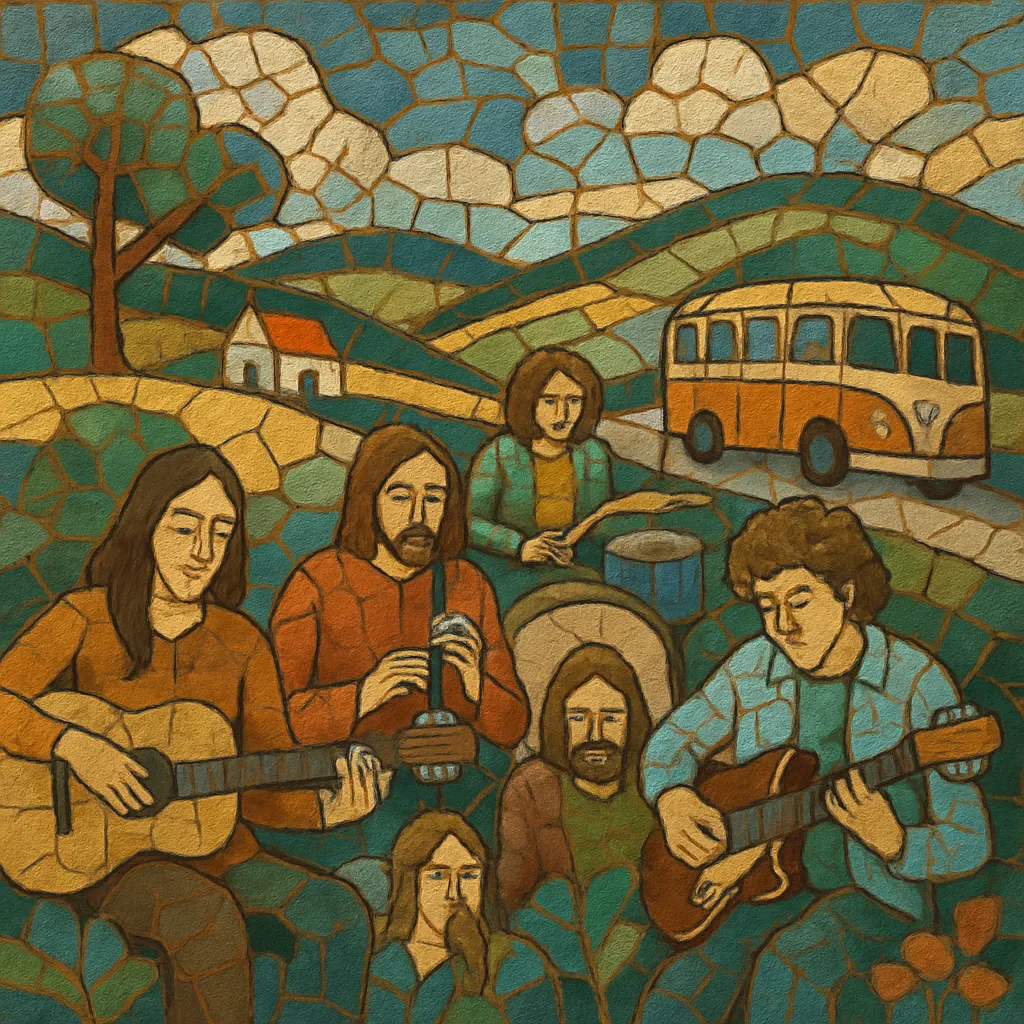
The Canterbury scene is a jazz-inflected branch of late‑1960s British progressive rock associated with musicians who emerged from the city of Canterbury, England. Its hallmark is a light, witty, and sophisticated approach that blends psychedelic rock textures with jazz harmony, contrapuntal writing, and long-form suites.
Characterized by extended chords (maj7, 9ths, 11ths), unusual time signatures, and graceful, conversational interplay, the style often features organ and electric piano (Lowrey/Hammond, Fender Rhodes), warm clean guitars, fuzz bass, and woodwinds (saxophone, flute). Vocals tend to be delicate and understated, carrying whimsical, surreal, or gently absurdist lyrics delivered with distinctly English humor.
The Canterbury scene coalesced around the short-lived but pivotal beat/psychedelic group The Wilde Flowers (1964–1967), whose members—most notably Robert Wyatt, Kevin Ayers, and Hugh Hopper—gave rise to two cornerstone bands: Soft Machine and Caravan. Early Soft Machine combined psychedelic rock’s exploratory spirit with jazz phrasing, while Caravan balanced melody and whimsy with extended instrumental passages.
By the early 1970s the scene matured into a distinct idiom. Soft Machine’s Third (1970) pivoted decisively toward jazz-oriented composition and improvisation, with long-form suites and electric-jazz instrumentation. Caravan’s In the Land of Grey and Pink (1971) epitomized the scene’s melodic warmth and humorous, pastoral sensibility.
A growing circle of interrelated bands cemented the style: Egg introduced rigorous contrapuntal keyboard writing; Matching Mole explored Robert Wyatt’s lyrical, jazz-touched songwriting; and the teams around keyboardist Dave Stewart—Hatfield and the North and later National Health—formalized the idiom with intricate meters, extended harmonies, and interlocking ensemble lines. Though based in France, Gong (founded by former Soft Machine member Daevid Allen) shared personnel and aesthetics and is often considered part of the broader Canterbury family.
The scene thrived on fluid lineups and a collaborative ethos, with musicians circulating between projects and mingling with the British jazz world (e.g., Elton Dean). Radio sessions, university circuits, and supportive labels helped disseminate the sound, while the music’s blend of composition and improvisation encouraged both formal experimentation and approachable charm.
The late 1970s punk/new wave shift curtailed the scene’s mainstream visibility, yet its vocabulary—light-touch jazz harmony in a rock context, metrically adventurous writing, and humane wit—echoed through jazz fusion, avant-prog/RIO, and later progressive revivals. Reissues, reunions, and new international groups keep the idiom alive, and the Canterbury approach remains a touchstone for musicians seeking an elegant, playful bridge between jazz sophistication and psychedelic/progressive rock imagination.
Use keyboards (Lowrey or Hammond organ, Fender Rhodes, acoustic piano), electric bass (often with a warm or fuzz tone), jazz-influenced drums (ride-focused, light touch; brushes where appropriate), clean or gently overdriven electric guitar, and woodwinds (saxophone, flute). Occasional synths, vibraphone, or clarinet can broaden the palette.
Favor extended jazz chords (maj7, m7, 9ths, 11ths, 13ths) and modal centers (Dorian, Mixolydian, Lydian). Voice-lead smoothly, allowing inner lines to move chromatically while bass lines outline modal vamps or stepwise motion. Use non-functional progressions and pivot tones for modulations. Borrow from modal jazz for soloing and comping language.
Write in diverse meters (5/4, 7/8, 9/8, 11/8) and employ metric modulations between sections. Keep the groove light and buoyant—more swing and ride-cymbal articulation than heavy backbeat—yet be ready to switch to straight feels for contrast. Counter-rhythms between keys, bass, and drums create the conversational pulse typical of the style.
Compose lyrical, pastoral themes that can be reharmonized or developed contrapuntally. Interweave sax/flute and keyboard/guitar lines rather than stacking block chords. Use recurring motifs and subtle variations to tie long-form pieces together.
Alternate through-composed sections with open solo spaces. Let solos grow from motivic seeds in the composition rather than generic head–solo–head forms. Employ sectional suites with short interludes, reprises, and gentle codas to maintain narrative flow.
Write whimsical, surreal, or gently satirical texts. Keep vocals soft and intimate, with close-mic clarity and occasional multi-part harmonies. Humor should feel light and conversational, never forced.
Aim for warm, natural tones with clear instrument separation. Use mild tape echo, plate/room reverb, subtle phasing/chorus, and minimal compression to preserve dynamics. Keep the mix airy to highlight interplay and nuance.
Transcribe short ensemble passages from cornerstone albums to study voicings and metric transitions. Rehearse slow, quiet dynamics to keep articulation controlled in odd meters. Workshop transitions between composed and improvised sections to ensure they feel organic rather than abrupt.

